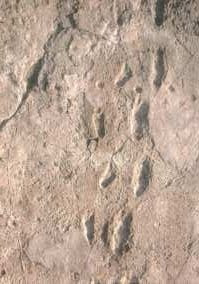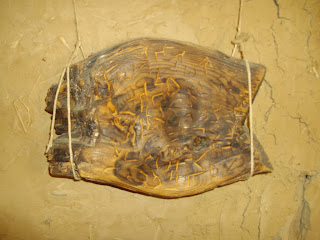Camminate umane di 3,7 milioni di anni fa studiate da ricercatori dell'università di Liverpool a partire dalle orme di Laetoli.
 Camminavamo da umani già 3,7 milioni di anni fa? Lo sostengono i ricercatori dell'università Liverpool, dopo aver simulato al computer i passi che originarono le undici orme di Laetoli, scoperte in Tanzania nel 1976. Secondo questa ricera le orme africane mostrano caratteristiche dei piedi e impronte tipiche dell'andatura da Sapiens. E la novità risiede nell'età di queste orme: più vecchia di due milioni di anni rispetto a ogni altra precedente ipotesi di camminata umana. Gran parte degli studi precedenti, infatti, indicavano che le caratteristiche del piede umano, come la capacità di usare l'alluce per spingere a terra e la posizione eretta a andatura bipede, si manifestò nel genere Homo non prima di 1,9 milioni di anni fa. Ho iniziato a interessarmi alle antiche orme dopo aver letto il romanzo di Arianna Dagnino, Fossili.
Camminavamo da umani già 3,7 milioni di anni fa? Lo sostengono i ricercatori dell'università Liverpool, dopo aver simulato al computer i passi che originarono le undici orme di Laetoli, scoperte in Tanzania nel 1976. Secondo questa ricera le orme africane mostrano caratteristiche dei piedi e impronte tipiche dell'andatura da Sapiens. E la novità risiede nell'età di queste orme: più vecchia di due milioni di anni rispetto a ogni altra precedente ipotesi di camminata umana. Gran parte degli studi precedenti, infatti, indicavano che le caratteristiche del piede umano, come la capacità di usare l'alluce per spingere a terra e la posizione eretta a andatura bipede, si manifestò nel genere Homo non prima di 1,9 milioni di anni fa. Ho iniziato a interessarmi alle antiche orme dopo aver letto il romanzo di Arianna Dagnino, Fossili.  E oggi questa notizia mi stuzzica particolarmente, anche per le tecniche utilizzate dagli scienziati inglesi. Sfruttando tecniche impiegate nell'imaging funzionale cerebrale e metodi statistici, i ricercatori di Liverpool, insieme ai colleghi delle università di Manchester e Bournemouth, hanno ricavato una media tridimensionale delle impronte del sentiero di Laetoli, arrivando a dimostrare che le orme dei nostri antenati risalgono a 3.7 milioni di anni fa. Il risultato della ricerca è pubblicato sulla rivista della Royal Society: Interface).
E oggi questa notizia mi stuzzica particolarmente, anche per le tecniche utilizzate dagli scienziati inglesi. Sfruttando tecniche impiegate nell'imaging funzionale cerebrale e metodi statistici, i ricercatori di Liverpool, insieme ai colleghi delle università di Manchester e Bournemouth, hanno ricavato una media tridimensionale delle impronte del sentiero di Laetoli, arrivando a dimostrare che le orme dei nostri antenati risalgono a 3.7 milioni di anni fa. Il risultato della ricerca è pubblicato sulla rivista della Royal Society: Interface).Le orme di Laetoli, istantanea di pietra della camminata dei nostri antenati, continuano a dirci qualcosa a distanza di quasi quattro milioni di anni.
La figura in alto a sinistra mostra una simulazione al computer utilizzata per valutare il tipo di camminata a partire dalle orme. La figura a destra ritrare le impronte di Laetoli.
Andrea Mameli - www.linguaggiomacchina.it - 22 luglio 2011
Ancient footprints show human-like walking began nearly four million years ago University of Liverpool (July 20, 2011)
Human-like external function of the foot, and fully upright gait, confirmed in the 3.66 million year old Laetoli hominin footprints by topographic statistics, experimental footprint-formation and computer simulation Robin H. Crompton, Todd C. Pataky, Russell Savage, Kristiaan D'Août, Matthew R. Bennett, Michael H. Day, Karl Bates, Sarita Morse, William I. Sellers (Journal of the Royal Society Interface, 2011).
Abstract
It is commonly held that the major functional features of the human foot (e.g. a functional longitudinal medial arch, lateral to medial force transfer and hallucal (big-toe) push-off) appear only in the last 2 Myr, but functional interpretations of footbones and footprints of early human ancestors (hominins) prior to 2 million years ago (Mya) remain contradictory. Pixel-wise topographical statistical analysis of Laetoli footprint morphology, compared with results from experimental studies of footprint formation; foot-pressure measurements in bipedalism of humans and non-human great apes; and computer simulation techniques, indicate that most of these functional features were already present, albeit less strongly expressed than in ourselves, in the maker of the Laetoli G-1 footprint trail, 3.66 Mya. This finding provides strong support to those previous studies which have interpreted the G-1 prints as generally modern in aspect.



Commenti